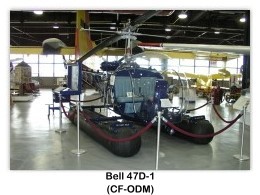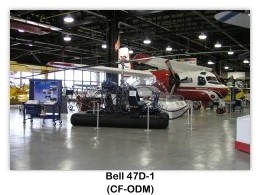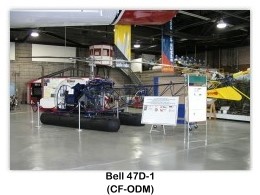

























Bell Model 47D-1
United States — three-seat general utility helicopter
Archive Photos
Bell Model 47D-1 (CF-ODM) at the Canadian Bushplane Heritage Centre, Sault Ste. Marie, Ontario, Canada



Overview
The Bell 47 is a two-bladed, single engine, light helicopter manufactured by Bell Helicopter. Based on the third Model 30 prototype, Bell’s first helicopter designed by Arthur M. Young, the Bell 47 became the first helicopter certified for civilian use on 8 March 1946. More than 5,600 Bell 47 aircraft were produced, including aircraft produced under license by Agusta in Italy, Kawasaki Heavy Industries in Japan, and Westland Aircraft in the United Kingdom. The Bell 47J Ranger is modified version with a fully enclosed cabin and fuselage.
- Role: Multipurpose light helicopter
- Manufacturer: Bell Helicopter
- Designed by: Arthur M. Young
- First flight: 8 December 1945
- Introduced: 1946
- Primary users: United States Army, British Army
- Produced: 1946-1974
- Number built: 5,600
- Developed from: Bell Model 30
- Variants: H-13 Sioux, Bell 47J Ranger, Kawasaki KH-4
Design and Development
Early models were variable in appearance, with open cockpits or sheet metal cabins, covered or open structures, some with four-wheel landing gear. Model D and Korean War types settled to a more utilitarian style. The most common model, the 47G introduced in 1953, can be recognized by the full bubble canopy, exposed welded-tube tail boom, saddle fuel tanks, and skid landing gear.
Later 47H had a regular cabin with full cowling and monocoque tail boom. Engines were Franklin or Lycoming horizontally-opposed piston engines of 200 to 305 HP (150 to 230 kW). Seating varied from two to four. Many are still in use as trainers and in agriculture (as of 2005).
H-13 were produced in Japan by a Bell and Kawasaki venture; this led to the Kawasaki KH-4 variant, essentially a three seat version of the Model 47.
Operational History
The Bell 47 helicopter entered U.S. military service in late 1946, in a variety of versions and designations for three decades. In the Korean War, it was designated the H-13 Sioux by the United States Army. It has also served as the helicopter of choice for basic helicopter flight instruction in many countries.
NASA had a number of Bell 47s during the Apollo program, used by astronauts as a trainer for the Lunar Lander. Eugene Cernan had a near disastrous accident shortly before his flight to the moon on Apollo 17 by crashing one into the Indian River.
The Los Angeles County Fire Department in California used the Bell 47 as the department’s very first aircraft in 1957.
Records
- 13 May 1949, a Bell 47 set an altitude record of 18,550 feet (5,650 m).
- 21 September 1950, first helicopter to fly over the Alps.
- 17 September 1952, Bell pilot Elton J. Smith set a world distance record of 1,217 mi (1,959 km), by flying nonstop from Hurst, Texas to Buffalo, New York.
Variants
Civilian Variants
- Bell 47: Pre-production version, powered by a 133-kW (178-hp) Franklin piston engine.
- Bell 47A: Improved version of the Bell 47, powered by a 117-kW (157-hp) Franklin O-335-1 piston engine.
- Bell 47B: Equivalent to the military YR-13/HTL-1, powered by the Franklin O-335-1 piston engine.
- Bell 47B-3: Agricultural/utility version with open crew positions.
- Bell 47C:
- Bell 47D: First to appear with a moulded "goldfish bowl" canopy.
- Bell 47D-1: Introduced in 1949, it had an open tube-work tailboom reminiscent of the Bell Model 30, ship number 3, and a three-seat configuration.
- Bell 47E: Powered by a 149-kW (200-hp) Franklin 6V4-200-C32 engine.
- Bell 47F:
- Bell 47G: Combines a 149 kW Franklin engine with the three-seat configuration of the 47D-1 and introduced the saddle-bag fuel tank configuration.
- Bell 47G-2: Powered by the Lycoming VO-435 engine. Produced under license by Westland Aircraft as the Westland Sioux, for the UK military.
- Bell 47G-2A: Powered by a 179 kW version of the VO-435.
- Bell 47G-2A-1: Wider cabin, improved rotor blades and increased fuel capacity.
- Bell 47G-3: Powered by a supercharged 168 kW Franklin 6VS-335-A.
- Bell 47G-3B: Powered by a turbocharged 209 kW Avco Lycoming TVO-435.
- Bell 47G-4: Three-seat helicopter powered by an Avco Lycoming VO-540 engine.
- Bell 47G-5: A three-seat, utility version. A two-seat agricultural version was later known as the Ag-5. The 47G-5 was the last model to be produced by Bell.
- Bell 47H-1: A three-seat version with an enclosed cabin and fuselage.
- Bell 47J Ranger: A four-seat version powered by an Avco Lycoming VO-435 engine.
Military Variants
- YR-13/HTL-1: 28 Bell 47A helicopters procured by the United States Army Air Forces for evaluation. The YR-13 was powered by a 175 hp (130 kW) Franklin O-335-1 piston engine. 10 of the aircraft were evaluated by the U.S. Navy as trainers.
- YR-13A: 3 YR-13 aircraft winterized for cold-weather testing in Alaska. Redesignated YH-13A in 1948.
- HTL-2: US Navy equivalent of the commercial Model 47D. 12 built.
- HTL-3: US Navy equivalent of the commercial Model 47E, powered by a 200 hp (149 kW ) Franklin 6V4-200-C32 engine. Nine built.
- H-13B: 65 aircraft ordered in 1948 by the U.S. Army. All Army versions were later named Sioux.
- YH-13C: One H-13B used as engineering testbed. Fitted with skid undercarriage and open, uncovered tailboom.
- H-13C: 16 H-13B aircraft converted to carry external stretchers in 1952, with skid landing gear and open tail boom of YH-13C.
- H-13D: Army two-seat version based on commercial model 47D-1, with skid landing gear, stretcher carriers, and Franklin O-335-5 engine. 87 built.
- OH-13E: H-13D configuration with three-seat aircraft with dual controls. 490 built.
- XH-13F/Bell 201: Modified Bell 47G powered by a Continental XT51-T-3 (Turbomeca Artouste) turboshaft. The first Bell helicopter powered by a turbine engine.
- OH-13G: Three-seater based on commercial model 47-G. Introduced a small elevator on the tailboom. 265 delivered to US Army.
- OH-13H/UH-13H: Based on 47G-2. Equipped with a 250 hp (186 kW) Lycoming VO-435 engine. At least 453 acquired by US Army. UH-14Hs were used by the U.S. Air Force.
- UH-13J: Two Bell 47J-1 Rangers acquired by the U.S. Air Force for VIP transport of the U.S. President. Originally designated as H-13J.
- OH-13K: Two converted H-14Hs with a larger diameter rotor and a 225 hp (168 kW) Franklin 6VS-335 engine for test evaluation.
- TH-13L: Originally designated as the Navy HTL-4.
- HTL-5: Utilized a Lycoming O-335-5 engine.
- TH-13M: Incorporated a small movable elevator. Originally designated as the Navy HTL-6.
- HH-13Q: Originally the HUL-1G, it was used by the U.S. Coast Guard for search and rescue.
- UH-13R: Powered by an Allison YT63-A-3 turboshaft engine. Original US Navy designation HUL-1M.
- OH-13S: Three-seat observation helicopter based on 47G-3B to replace the OH-13H. 265 received by US Army.
- TH-13T: Two-seat instrument trainer for the U.S. Army based on the 47G-3B-1, powered by 270 hp (201 kW) Lycoming TVO-435-D1B. 411 purchased.
- Sioux AH.1: General purpose helicopter for the British Army, 50 built by Agusta (Agusta-Bell 47G-3B1) and 250 built by Westland (Westland-Augusta-Bell 47G-3B1).
- Sioux HT.2: Training helicopter for the Royal Air Force, 15 built by Westland.
Licensed Versions
- Agusta A.115: 1971 Italian prototype of a Bell 47J with an unclad, tubular tail boom, and powered by a Turboméca Astazou II turboshaft engine.
- Meridionali/Agusta EMA 124: Italian prototype with redesigned forward fuselage. Not produced.
- Kawasaki KH-4: Japanese production version with redesigned, lengthened cabin, and redesigned control system
Conversions
- Carson Super C-4
- El Tomcat Mk.II: Bell 47G-2 modified extensively for agricultural spraying by Continental Copters Inc. First flew in April 1959. Followed by further improved versions.
Government Operators
Specifications (Bell 47G-3B)
General Characteristics
- Crew: 1 or 2
- Capacity: 1 passenger or 2 litters
- Length: 31 ft 7 in (9.63 m)
- Rotor diameter: 37 ft 2 in (11.32 m)
- Height: 9 ft 3 in (2.83 m)
- Disc area: 1,085 ft² (100.8 m²)
- Empty weight: 1,893 lb (858 kg)
- Useful load: 1,057 lb (482 kg)
- Max takeoff weight: 2,950 lb (1,340 kg)
- Powerplant: 1× Lycoming TVO-435-F1A flat, six-cylinder, reciprocating engine, 280 hp (210 kW)
Performance
- Maximum speed: 91 knots (105 mph, 169 km/h)
- Cruise speed: 73 knots (84 mph, 135 km/h)
- Range: 214 nmi (245 mi, 395 km)
- Rate of climb: 860 ft/min (4.37 m/s)
Popular Culture
The Bell 47 appeared, and played key roles, in film and television productions. It has been associated with both the M*A*S*H film, and the M*A*S*H television series, and the Whirlybirds TV series (1957-1959).
References
- Shupek, John. Photos via The Skytamer Archive, copyright © 2009 Skytamer Images. All Rights Reserved
- Wikipedia, the free encyclopedia. Bell 47
- Wikipedia, the free encyclopedia. H-13 Sioux































































